Harishyam Arts Blog
Dome or No Dome? Choosing the Right Design for Your Home Temple
By Lakshay Sharma | On 21 October, 2025 | Views
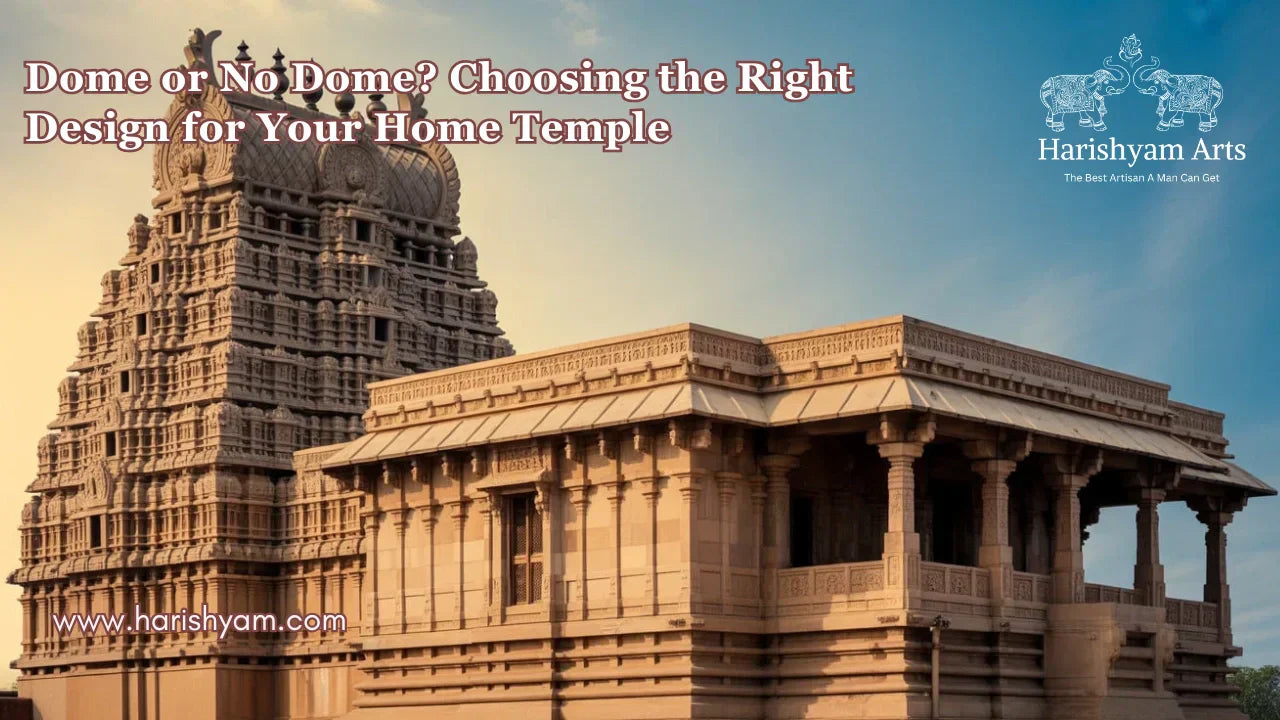
Creating a sacred space at home is a spiritual investment, and the design of your home temple (mandir) plays a crucial role in enhancing positive energy. One of the most debated questions among devotees and interior enthusiasts is: Should your home temple have a dome or a flat roof? This guide will help you make the right choice by exploring traditional wisdom, modern trends, and practical design considerations for wooden, marble, and Corian mandirs.
Should Home Temple Have a Dome as per Vastu?
According to Vastu Shastra, a dome-shaped roof in a mandir symbolizes the celestial sphere and divine energy. It is believed to amplify positive vibrations, bringing peace, prosperity, and spiritual well-being to the household. While flat-roof temples are also acceptable, a dome is considered auspicious, especially for spaces where meditation and daily worship are performed.
Benefits of Having a Dome in Home Mandir
-
Spiritual Elevation: Domes represent the connection between earth and sky, helping channel divine energy.
-
Aesthetic Appeal: A dome instantly elevates the elegance of wooden, marble, or Corian mandirs.
-
Enhanced Acoustics: Domes naturally amplify sound, which is perfect for chanting, bells, and devotional music.
-
Symbolic Significance: In Hindu culture, domes are symbolic of the universe and divine consciousness.
Difference Between Dome and Flat Roof Temple Design
|
Feature |
Dome Mandir |
Flat Roof Mandir |
|
Spiritual Significance |
High, channels divine energy |
Moderate, simpler energy flow |
|
Aesthetic Appeal |
Traditional, majestic |
Minimalistic, modern |
|
Material Options |
Wood, Marble, Corian |
Wood, Marble, Corian |
|
Construction Complexity |
More complex |
Easier |
Modern vs Traditional Temple Dome Design Ideas
-
Traditional Domes: Intricate carvings, tiered layers, often seen in marble or wooden mandirs.
-
Modern Domes: Sleek, minimal, sometimes made with Corian for a contemporary look.
-
Combination Styles: Traditional motifs with modern materials like Corian or blended wood and marble for a fusion appeal.
Ideal Mandir Design for Home as per Vastu Shastra
-
Placement: Ideally in the northeast corner of the house for maximum positivity.
-
Height: Slightly elevated platform is recommended.
-
Orientation: Facing east or west is considered auspicious.
-
Material Choice:
-
Teak Wooden Mandir: Durable, warm, easy to carve for domes.
-
White Marble Mandir: Elegant, traditional, stays cool, ideal for intricate dome work.
-
Backlit Corian Mandir: Modern, lightweight, customizable designs, and easy maintenance.
FAQs – Choosing the Right Design for Your Home Temple
Q1. Should a home temple have a dome according to Vastu?
Ans: Yes, according to Vastu Shastra, having a dome in your home temple is highly auspicious. It helps attract positive energy, peace, and prosperity. The dome represents the connection between the devotee and divine energy, symbolizing the cosmic link between heaven and earth.
Q2. What are the benefits of adding a dome to a home mandir?
Ans: A dome enhances the divine aura of your home temple. It improves spiritual vibrations, amplifies sound during prayers, and adds grandeur to the design. Whether your mandir is made of wood, marble, or Corian, a dome brings beauty, energy balance, and traditional elegance to your sacred space.
Q3. Which is better for home temples – dome or flat roof design?
Ans: Both designs have their appeal. Dome temples are traditional, spiritually powerful, and visually majestic. Flat roof temples suit modern interiors and smaller spaces. If Vastu and devotion are priorities, choose a dome; if simplicity and minimalism matter, a flat roof design may be ideal.
Q4. What are the Vastu guidelines for temple dome design at home?
Ans: According to Vastu, domes should be rounded, centered above the deity, and not touch the ceiling. The mandir should face east or northeast, symbolizing divine light and prosperity. A properly designed dome helps maintain energy flow, creating a peaceful and positive environment in your home.
Q5. How to choose the right dome design for your home mandir?
Ans: Consider your home’s space, ceiling height, and décor style. Choose carved wooden domes for traditional homes, marble domes for grandeur, and Corian domes for minimalist designs. Always ensure alignment with Vastu Shastra for direction, shape, and placement to enhance positive energy and aesthetics.
Q5. How to Clean a Wooden Mandir at Home?
Ans: To clean a wooden mandir, gently dust daily with a soft, dry cloth. Once a week, wipe with a slightly damp microfiber cloth. Avoid harsh chemicals or excess water to protect the wood polish. For deep cleaning, use natural oils like lemon or coconut oil to maintain shine and fragrance.
How to Choose the Right Home Temple Design
-
Assess the available space and ceiling height for a dome.
-
Decide on material: Wooden for warmth and tradition, marble for elegance, Corian for modern minimalist style.
-
Consider maintenance: Marble and Corian are easier to clean than wooden mandirs in humid conditions.
-
Align with Vastu guidelines for home mandir for orientation and placement.
Temple Dome Meaning and Importance in Hindu Culture
In Hindu architecture, the dome (or Shikhara) represents Mount Meru, the mythical mountain considered the axis of the universe. It is a reminder of divine presence and spiritual ascent. A dome also serves as a symbolic canopy, signifying protection, sanctity, and the celestial abode of the deities.
Buying Online? Tips from Harishyam Arts
When buying a home temple online, especially from trusted platforms like Harishyam Arts, consider these points:
-
Check dimensions carefully.
-
Confirm the material and finish.
-
Read reviews for quality and durability.
-
Ensure the temple suits your home’s Vastu requirements.
Conclusion
Whether you choose a dome or a flat-top temple depends on your space, budget, and aesthetic preference. Dome temples bring a traditional, spiritual vibe, while no-dome temples fit modern interiors seamlessly. The key is to create a sacred space that inspires devotion and tranquility
Choosing whether to have a dome or a flat roof for your home temple depends on space, material, and personal preference, but incorporating a dome as per Vastu Shastra adds both spiritual and aesthetic value. Whether you choose a wooden, marble, or Corian mandir, a dome elevates the sacred experience, making your home a true sanctuary of peace and devotion.
Creating a sacred space at home is a spiritual investment, and the design of your home temple (mandir) plays a crucial role in enhancing positive energy. One of the most debated questions among devotees and interior enthusiasts is: Should your home temple have a dome or a flat roof?...

Lakshay Sharma
I’m Lakshay Sharma, a writer with a deep passion for Hindu mythology, Vastu Shastra, and home interiors. I enjoy exploring the rich traditions of Hindu gods and goddesses, sharing insights into Vastu principles, and offering guidance on creating sacred spaces like Puja Mandirs. Through my writing, I aim to inspire harmony and spiritual well-being, blending traditional knowledge with modern perspectives.
Harishyam Arts | Jaipur
Related Blogs

Guide to Inlay, Meenakari and Gold Leaf Work on Marble Idols
Lakshay Sharma | December 06, 2025
Marble has been cherished for centuries for its timeless beauty, durability, a...
Read More...
Brass Idols vs. Other Materials: Comparing Durability, Look, and Spiritual Aura
Lakshay Sharma | December 05, 2025
In the world of sacred art and worship, the material chosen for an idol or mur...
Read More...
Makar Sankranti 2026: Date, Significance, Puja Method, and Celebration Tips
Lakshay Sharma | December 04, 2025
Makar Sankranti is one of the most awaited festivals in India, celebrated with...
Read More...
Teak Wood, Sheesham and MDF for Mandirs: Pros and Cons Explained
Lakshay Sharma | December 03, 2025
Choosing the right material for your home mandir is an important decision—one ...
Read More...
First-Time Buyer Guide to Ordering Custom Marble Murtis Online from Jaipur
Lakshay Sharma | December 02, 2025
Why Jaipur Is Famous for Marble Murtis
Jaipur ...
Read More...
Why Carved Teak Wood Furniture Is Making a Comeback in Indian Homes
Lakshay Sharma | December 01, 2025
Indian homes have always embraced tradition, craftsmanship, and timeless beaut...
Read More...
How to Choose the Ideal Pooja Mandir for Your Home: Material, Size, and Style
Lakshay Sharma | November 30, 2025
A pooja mandir is the sacred heart of every Indian home, where spirituality me...
Read More...Who is Ghantaghar Mahavir Swami? The Spiritual Legacy Behind the Iconic Name
Lakshay Sharma | November 29, 2025
The term “Ghantaghar Mahavir Swami” refers to the di...
Read More...
Guidelines for gifting god idols to others
Lakshay Sharma | November 28, 2025
Gifting a God idol is considered a highly auspicious act in Indian tradition. ...
Read More...
What happens if God idol breaks by mistake
Lakshay Sharma | November 27, 2025
God idols represent purity, devotion, and divine energy in every Hindu home. W...
Read More...
Mixing Materials: Marble Mandirs with Wooden, Brass, or Metal Accents
Lakshay Sharma | November 26, 2025
Combining marble with wooden, brass, or metal accents transforms a simple mand...
Read More...
Step-by-Step Guide to Professional Marble Statue Repainting
Lakshay Sharma | November 24, 2025
Marble statues are timeless masterpieces that reflect devotion, beauty, and cr...
Read More...
Is It Okay to Hang a Mandir on a Wall? A Complete Guide to Wall-Mounted Temples
Lakshay Sharma | November 23, 2025
In today’s fast-paced world, where urban homes are becoming more compact and s...
Read More...
Who is Parashvanath? The Life and Legacy of Jainism’s 23rd Tirthankara
Lakshay Sharma | November 22, 2025
Faith and spirituality are cornerstones of Indian tradition, and Jainism stand...
Read More...
How to Choose Between Carved and Minimalistic Wooden Mandirs
Lakshay Sharma | November 21, 2025
A home mandir (temple) is far more than just a piece of furniture; it is the s...
Read More...
How to clean silver god idols at home
Lakshay Sharma | November 21, 2025
At Harishyam Arts, we understand the spiritual and aesthetic significance of s...
Read More...
Are Marble Dust Statues Ideal for Your Home Temple? Pros & Cons
Lakshay Sharma | November 19, 2025
When it comes to selecting statues for your home temple, marble dust statues h...
Read More...
Where to Buy Authentic Marble Gods' Moortis in the USA: A Guide for Devotees and Collectors
Lakshay Sharma | November 19, 2025
For devotees and collectors in the USA seeking authentic marble Hindu god moor...
Read More...
Maa Parvati 108 Names in Sanskrit and English: Their Significance, Meaning, and Mantra Power
Lakshay Sharma | November 17, 2025
The Divine Essence of Maa Parvati
Maa Parvati,...
Read More...
8 Guidelines for Setting Up Your Home Mandir with Wooden Murtis: Location, Selection, and Maintenance.
Lakshay Sharma | November 16, 2025
Introduction: The Divine Mother of Strength and Compassion

Who Was Jain Mahavir? The Life, Teachings, and Legacy of the 24th Tirthankara
Lakshay Sharma | November 15, 2025
Lord Mahavir, the 24th Tirthankara of Jainism, was a spiritual reformer who re...
Read More...
Benefits of Choosing Corian Mandirs Over Marble and Wood
Lakshay Sharma | November 14, 2025
Modern homes today demand elegance, functionality, and easy upkeep — and Coria...
Read More...
White vs. Black Shivling: Which One Is Best for Your Home and Why?
Lakshay Sharma | November 13, 2025
The Shivling, a sacred symbol of Lord Shiva, embodies creation, power, and pur...
Read More...
10 Stunning Marble Handicraft Pieces to Elevate Your Home Décor
Lakshay Sharma | November 12, 2025
Marble handicrafts represent timeless artistry, luxury, and devotion. At Haris...
Read More...
Brass Ganesha Idols as Gifts: Symbolism, Occasions, and Gifting Etiquette
Lakshay Sharma | November 11, 2025
Gifting a brass Ganesha idol is more than a gesture—it's a blessing of prosper...
Read More...
Luxury Kids Room Decor Ideas That Turn Every Space Into a Fairytale Dream
Lakshay Sharma | November 10, 2025
Transforming a child’s room into a luxury fairytale dream combines comfort wit...
Read More...
Why Repainting Your Marble Statue Can Extend Its Life and Beauty
Lakshay Sharma | November 09, 2025
Marble statues are elegant pieces of art that add charm to any home or temple....
Read More...
How to Choose the Perfect Wall-Mounted Wooden Mandir for Your Home
Lakshay Sharma | November 08, 2025
A wall-mounted wooden mandir is more than just a spiritual corner; it’s a blen...
Read More...
Understanding GST on Marble God Statues: A Complete Guide for Buyers and Sellers
Lakshay Sharma | November 07, 2025
Marble god statues are a popular choice for temples, homes, and offices due to...
Read More...
Are Wooden Statues Pest-Resistant? How to Protect Your Wooden Idols from Insects and Damage
Lakshay Sharma | November 06, 2025
Wooden statues have been cherished for centuries due to their natural beauty a...
Read More...
Corian vs Wooden Temples: Which One Should You Choose?
Lakshay Sharma | November 05, 2025
Choosing the perfect temple for your home is more than just selecting a design...
Read More...
How Customised Marble Human Bust Manufacturers Bring Personalities to Life
Lakshay Sharma | November 04, 2025
Crafting a marble human bust is so much more than sculpting a likeness—it's ab...
Read More...
The Power of the Hare Krishna Maha Mantra: Awakening Spiritual Bliss
Lakshay Sharma | November 03, 2025
The Hare Krishna Maha Mantra is a sacred chant that ...
Read More...
The 24 Tirthankaras of Jainism: Names, Symbols, and Significance
Lakshay Sharma | November 02, 2025
In Jainism, the Tirthankaras are revered as divine s...
Read More...
Top 25 Space-Saving Wooden Mandir Ideas for Modern Homes
Lakshay Sharma | November 01, 2025
A pooja mandir is the heart of every Indian home — a sacred corner where peace...
Read More...
What Are the 8 Forms of Lakshmi? | Ashta Lakshmi Meaning and Significance
Lakshay Sharma | October 31, 2025
The Divine Essence of Goddess Lakshmi
Goddess La...
Read More...
The Art of Craftsmanship: How Handmade Brass Statues Are Created
Lakshay Sharma | October 30, 2025
At Harishyam Arts, we celebrate the timeless beauty ...
Read More...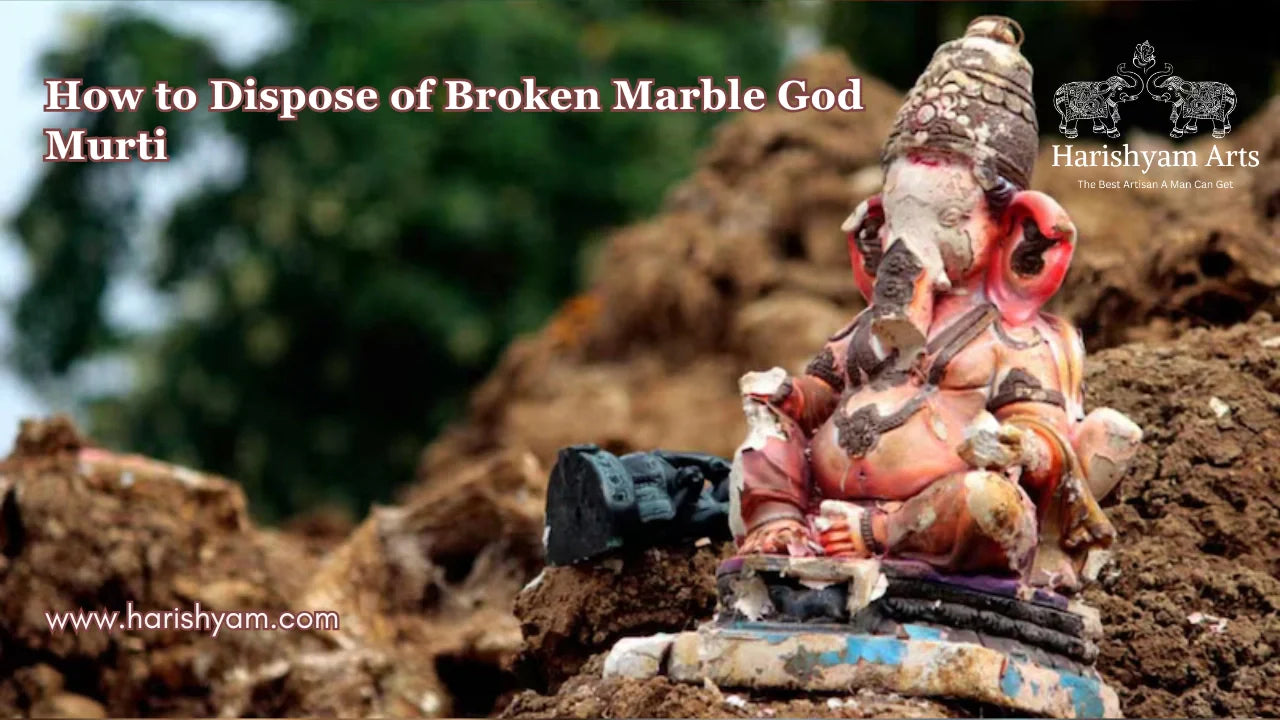
How to Dispose of Broken Marble God Murti
Lakshay Sharma | October 30, 2025
In Hindu tradition, marble murtis represent divine presence and spiritual ener...
Read More...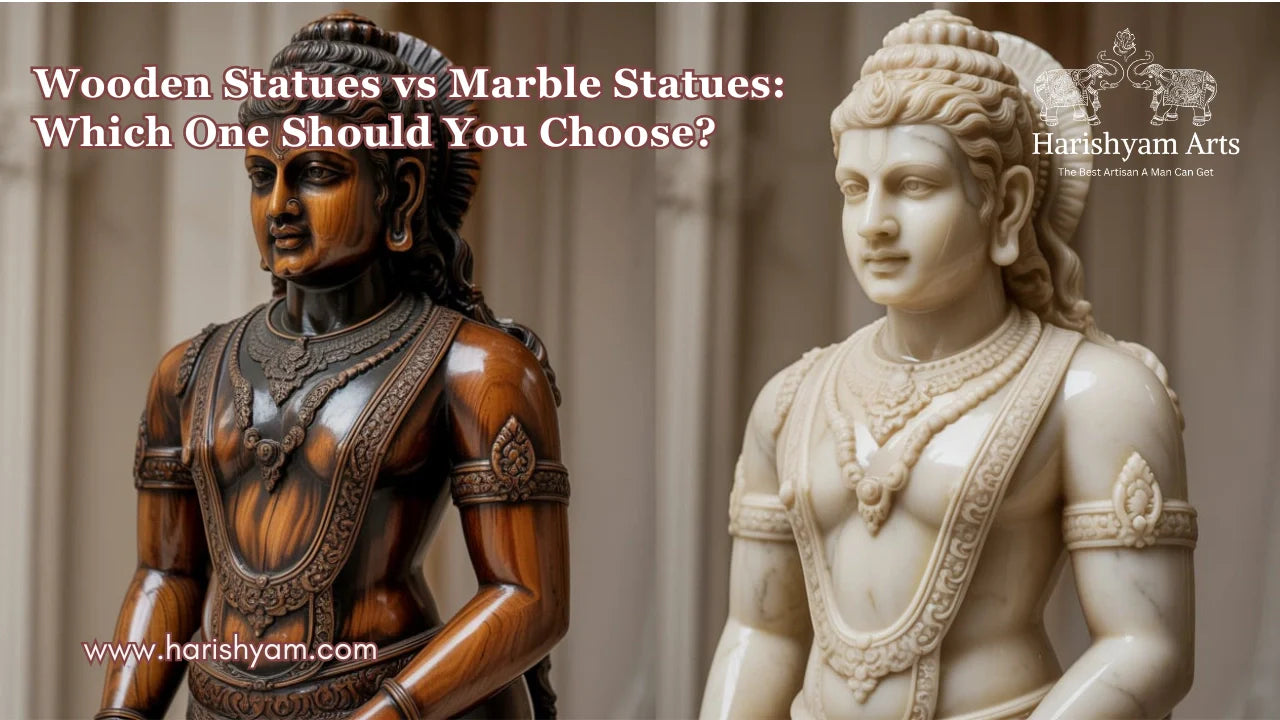
Wooden Statues vs Marble Statues: Which One Should You Choose?
Lakshay Sharma | October 29, 2025
When it comes to decorating your home or creating a sacred space, choosing the...
Read More...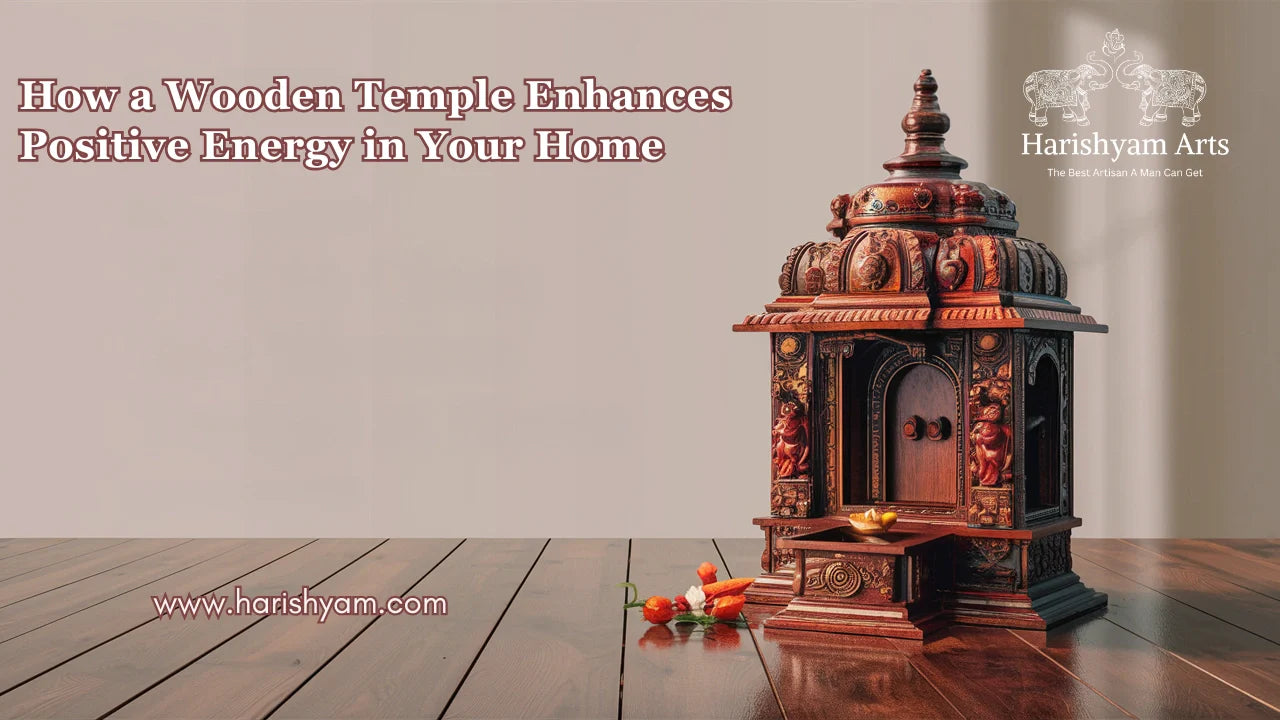
How a Wooden Temple Enhances Positive Energy in Your Home
Lakshay Sharma | October 28, 2025
A home temple isn’t just a decorative corner — it’s the spiritual...
Read More...
Why Lord Krishna is Worshipped in Different Forms Across India
Lakshay Sharma | October 27, 2025
Lord Krishna — the eighth incarnation of Lord Vishnu — is one of the most belo...
Read More...
The Story of Goddess Saraswati: The Embodiment of Wisdom and Knowledge
Lakshay Sharma | October 26, 2025
Among the many deities of the Hindu pantheon, Maa Saraswati Read More...
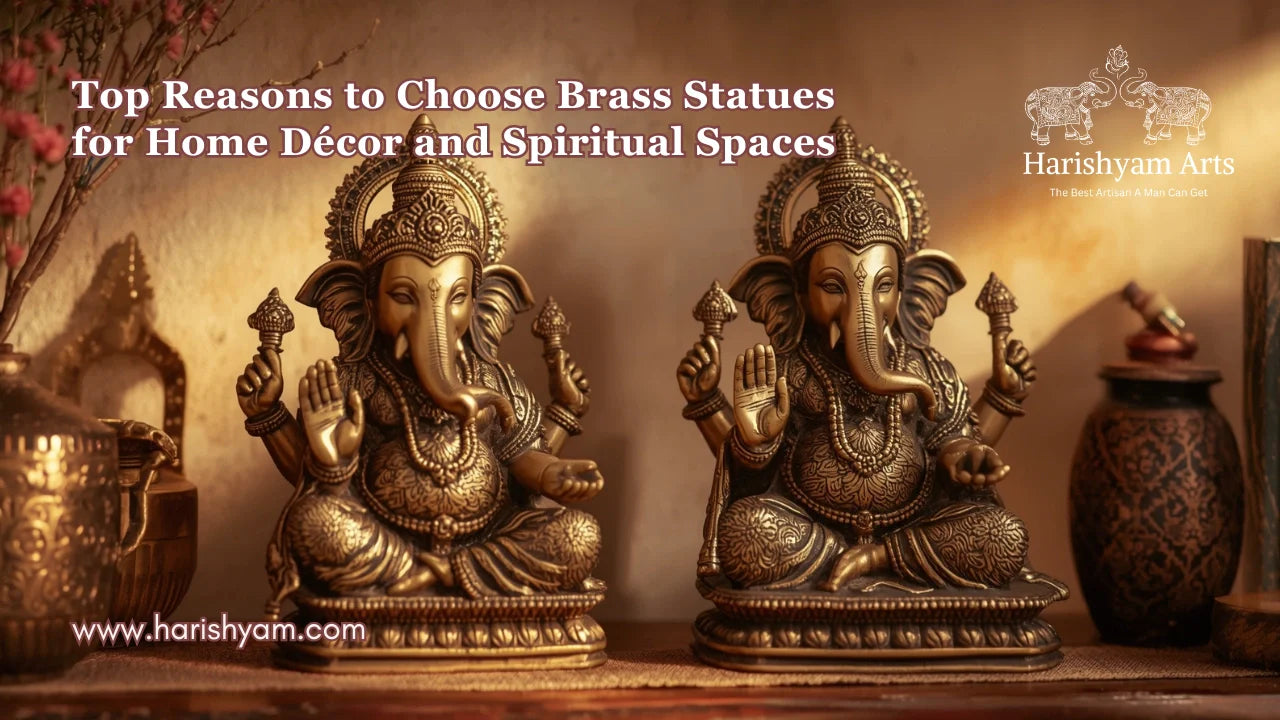
Top Reasons to Choose Brass Statues for Home Décor and Spiritual Spaces
Lakshay Sharma | October 25, 2025
Home décor today is not only about beauty—it’s about creating a peaceful and m...
Read More...
How long do Corian temples last?
Lakshay Sharma | October 24, 2025
Choosing the right material for a temple at home is important for both aesthet...
Read More...
Why Lord Shiva is Called the Mahadeva – The Supreme God
Lakshay Sharma | October 23, 2025
Hinduism, one of the world’s oldest religions, has a rich pantheon of deities,...
Read More...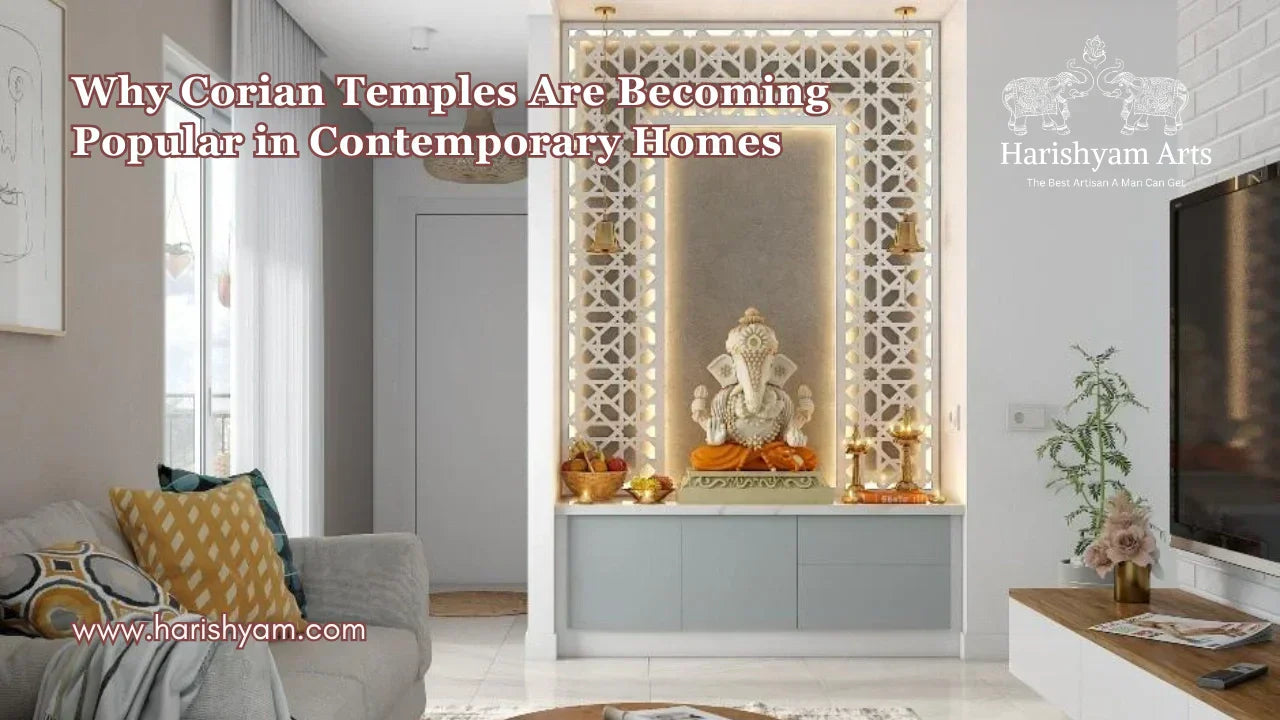
Why Corian Temples Are Becoming Popular in Contemporary Homes
Lakshay Sharma | October 22, 2025
In today’s modern homes, interior décor blends tradition with contemporary sty...
Read More...
Dome or No Dome? Choosing the Right Design for Your Home Temple
Lakshay Sharma | October 21, 2025
Creating a sacred space at home is a spiritual investment, and the design of y...
Read More...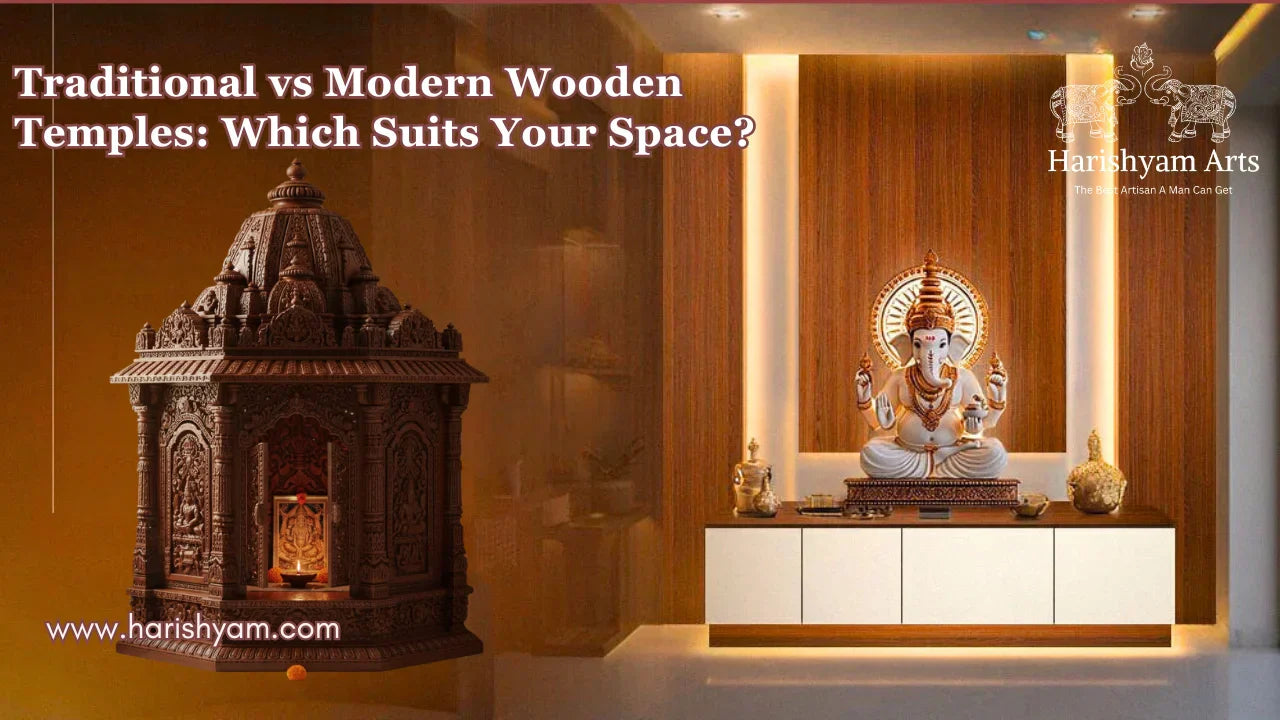
Traditional vs Modern Wooden Temples: Which Suits Your Space?
Lakshay Sharma | October 20, 2025
Creating a sacred space in your home is more than just interior décor — it’s a...
Read More...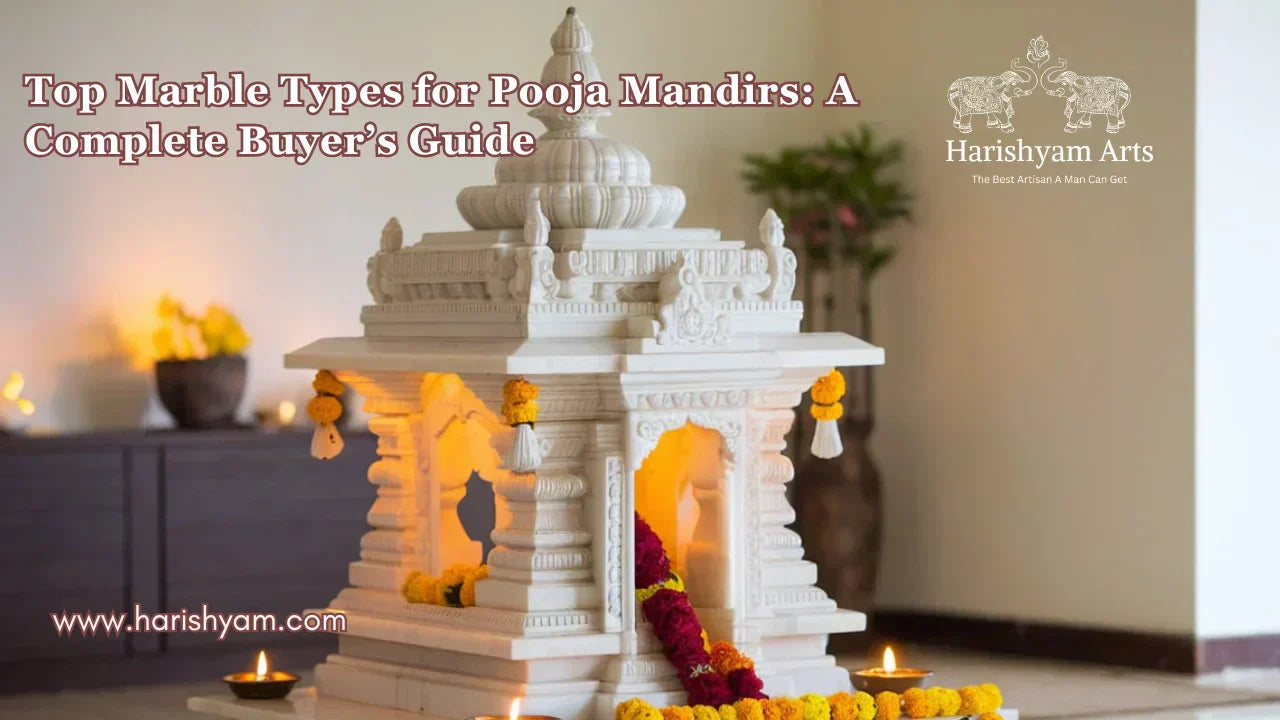
Top Marble Types for Pooja Mandirs: A Complete Buyer’s Guide
Lakshay Sharma | October 19, 2025
A Pooja Mandir is more than just furniture; it is th...
Read More...
The Different Forms of Shiva Statues and their Symbolism
Lakshay Sharma | October 18, 2025
Introduction to the God Shiva Statue
Lord Shiv...
Read More...



